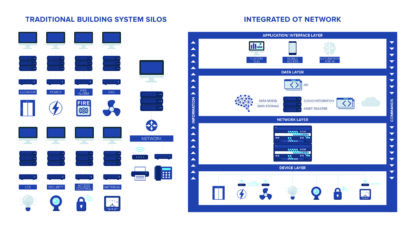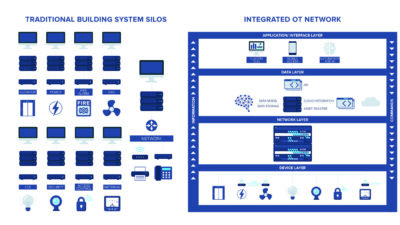Zoned HVAC strategies make sense for facilities that have varying heating and cooling loads. This month's roundtable participants discuss the technology, practical applications and benefits of zoning. Consulting-Specifying Engineer: What are the most common applications for zoned HVAC systems? KENSKY: Office environments, both enclosed and open office plans.
Zoned HVAC strategies make sense for facilities that have varying heating and cooling loads. This month’s roundtable participants discuss the technology, practical applications and benefits of zoning.
Consulting-Specifying Engineer: What are the most common applications for zoned HVAC systems?
KENSKY: Office environments, both enclosed and open office plans. The zoning allows the HVAC system to respond to the space needs, be it a perimeter office or interior open-plan workstations. In fact, even entirely open office plans, with workstations extending to the perimeter glazing, require zone control. This is because a perimeter exposure load can vary greatly throughout the day, compared to an interior zone. Spaces such as workstations, conference rooms, workrooms, copy centers and file areas all require different cooling/heating needs based on the number of occupants, the volume of equipment in the space and where they are located within the building.
SMITH: Any building that has significantly different heating or cooling loads in one part of the building vs. another is ideal for zoned HVAC. This most often occurs when there is significant solar exposure through windows on one side of a building, or internal loads such as high computer density in only some parts of the building. Of course, if there is only one central system to provide HVAC for an entire building, and there are big variations in the loads throughout the building, some zones will be too hot, some too cold.
KENSKY: When it comes to occupant comfort, each occupant has his or her own tolerances for climatic conditions. But zoning must be limited in order to have a reasonable level of control. The larger the control zone, the less the system fine-tuning.
CSE: What are some of the latest technologies and designs in zoned HVAC?
KENSKY: Localized zoning and control is one of the most common strategies today. This is accomplished in many ways, such as:
-
Manually adjustable diffusers in the workstation for a raised-floor system.
-
Personalized A/C systems that offer control over supply air, space heating, lighting and white noise at each desktop.
-
Wireless thermostats/sensors mounted on workstation cubicles. Multiple sensors average space temperature and report back to the VAV or water source heat pump (WSHP) systems.
CSE: How has this changed over the past few years?
KENSKY: Zones used to be larger, because controls were expensive. But as the cost of controls has dropped and new technologies have arisen, the control zone sizes have become smaller, resulting in improved control. The most flexible and cost-effective system today makes use of manually adjustable floor diffusers within workstations on a raised-floor system. This allows the occupant to open or close the vent to achieve the desired amount of heating or cooling for their space.
SMITH: Definitely. The evolution of controls is key. For medium to large commercial buildings in the United States, VAV systems are by far the most common for zoned HVAC. Even though VAV systems have been around for several decades, it’s the control systems that are getting more sophisticated.
And because processing power has dropped in price, manufacturers can provide fully programmable field controllers instead of inflexible, “canned” control strategies. Today’s fully programmable systems use information from the entire system—including data on outdoor conditions—to optimize comfort and energy savings.
CSE: Anything specific?
SMITH: An interesting innovation is the use of fan-powered, dual-duct VAV boxes, with one duct used for dedicated outside air. This design solves the age-old problem of assuring adequate outside air in all zones of a VAV system without overventilating most of the zones. Although the initial cost is a bit high, the energy savings in applications such as schools, which require high ventilation rates, can be substantial. The emergence of electronically commutated motors (ECM) in series fan-powered VAV boxes, combined with intelligent controls, provides another opportunity for significant energy savings. A signal from the controller can modulate the speed of these motors.
CSE: How are controls optimizing performance of zoned HVAC?
SCHULTZ: As Chuck noted, the cost constraints for controls have faded. With cost-effective DDC controllers, the industry can create very sophisticated applications that include multiple variables such as temperature, humidity and CO 2 . With properly designed central station equipment to serve the zone equipment, very high-quality performance is easily delivered. But most likely, the greatest enhancement of the past decade is the ability to monitor the performance of the systems at the zone level and take corrective action when deviations occur. As a result, consistency of performance has greatly increased.
CSE: On the subject of control sophistication, how much variance is possible within the zones of a facility?
SCHULTZ: It’s possible to provide as much variance as the customer wants. However, keep in mind that large variances in requirements will change design decisions and typically increase costs. Considerable variance requirements may change the design of the central systems that are serving the zone levels. For example, with a fan coil system, it may be necessary to have a four-pipe system, rather than a two-pipe system.
SMITH: There can be substantial variance in the HVAC load between rooms in a modern building. Although improvements in the building shell such as insulation and heat-absorbing glass reduce the effects of outside conditions, there can still be large variations in interior loads. A small interior room with lots of computer equipment or a conference room full of people can have a significant cooling load, even in winter, while an adjacent corner office with only a laptop and one person might have a significant heating load on the same day.
KENSKY: The variance can be experienced in degrees of temperature and cooling loads. Degrees of temperature can be sensed simply by walking through an open office plan where the occupants have direct access to the HVAC controls. Some areas can be two to four degrees warmer or cooler than adjacent areas, depending upon individual needs. Although it’s difficult to manage, the people who are typically warm—or cold—should be located together in the same zone. Mixing these types in the same zone will inevitably cause complaints that can’t be solved by thermostat settings. However, individual controls—as well as sweaters—may solve the problem.
Finally, the loads in a space can vary significantly based on equipment locations. For example, an area of workstations with printers in each cubicle will have a greater load than an area with a single printer at the end of the row. Depending on the equipment in the space and the size of the zone, this could easily amount to one to two tons of additional cooling.
CSE: In cases where occupants are given the freedom to control their personal environments, does this take a toll on energy efficiency? How is this kept in check?
SMITH: In most cases, it is best to allow occupants to adjust their individual set points—within limits—using a room sensor that has an adjustment lever or digital display. This also provides a field service access point. If occupants aren’t given some control, things like space heaters under desks begin to appear, which take a huge toll on energy efficiency. When the building has individual offices, the loss in energy efficiency—due to each zone operating independently—is not that great. In open office plans, however, the problem can be significant. Control systems that can be programmed to monitor adjacent zones in open floor plans can enforce limits on setpoint variation.
Another issue in personal environment control is after-hours system operation, which can consume considerable energy because the entire system must often be started to serve a single occupant. Ideally, the control programming is set up to activate the minimum number of zones required for system operation, as well as easily record the override so that the building owner can bill, or at least monitor, the tenant.
KENSKY: Typically, the electronic controls systems have a local thermostat with ranges of adjustment, usually about plus or minus two to four degrees. Limiting the range keeps the system in overall check.
Manually adjustable diffusers in the workstations typically do not have any limits. Since these systems are generally used in an underfloor-air system, the overall effect of closing a diffuser—or several on a large open plan system—is very insignificant. The raised floor is a common supply plenum and these systems are typically VAV, which adjusts the overall system performance based on the pressure of the underfloor system.
The energy efficiency for both types of controls systems is not compromised. Instead, the systems actually become more efficient when the users have some level of control over their environment. Overcooling and heating is eliminated or greatly reduced, thus the system is more efficient.
On the other hand, operable windows can play havoc with space temperatures and energy efficiency and should be carefully regulated to avoid these issues.
SCHULTZ: My golden rule is that energy savings shouldn’t be through customer pain. There are so many excellent strategies that can be used to efficiently deliver comfort. Consequently, going back to the federal guidelines on energy reduction that were in effect between 1976 and 1980 makes no sense at all. By monitoring all of the zones, it is possible to adjust the performance of the central station equipment to be very efficient in delivering a wide range of comfort. If all of the terminal units are in heating mode, the amount of central station cooling should be reduced. If all of the terminal unit dampers are choked down, the static pressure of the air stream should be reduced.
This being said, it is not necessary to give total control to the occupants. Instead, set point adjustments are limited to reasonable levels. Also, the override capability is controlled based on outside conditions and time of day.
There are so many “smart” procedures that can be used to keep energy consumption down, and some of these are not related to control algorithms. A good example is how a cleaning crew can affect energy consumption. If a crew of two spends six hours to clean an office environment and a crew of four can cut this time in half, the use of lighting and HVAC equipment run time can be reduced. It’s important to be aware that facility operating procedures are more than just controls.
CSE: How do you envision zoned HVAC being employed in the office of the future, say, a decade or two down the line?
KENSKY: With the continuing perfection and understanding of underfloor, more office environments will take on this approach. However, there is still a learning curve for the design, implementation and construction of these types of systems for the engineers, architects and construction teams alike.
SMITH: I think we may see the emergence of personal zones, possibly integrating HVAC with office or cubicle furniture. This delivers precisely ventilated air to avoid drafts, but gives the occupants the fresh air they need. We will probably see increased use of radiant heating and cooling, perhaps using thermo-electric cooling technology, allowing more control of each individual’s environment without competing with neighboring zones. A wireless interface accessible from the occupant’s computer would likely control each individual work space.
SCHULTZ: Right now, there is a lot of humidity control at the zone level. Consequently, this is a golden area for improvement with new technology. In addition, more friendly interaction between the customer and the control system is very likely, as well as voice activation of various aspects of the system. One other point is that better measurement of air quality may become more cost-effective and influence how the zone is supported.
Participants
Chuck B. Kensky , P.E. , Vice President, Bala Consulting Engineers, Wynnewood, Pa.
Bob Schultz , Chief Engineer, TAC-Americas, Carrollton, Texas
David Smith , P.E. , Senior Mechnical Engineer, Alerton, Redmond, Wash.



